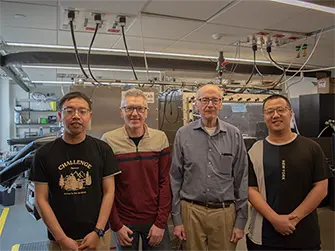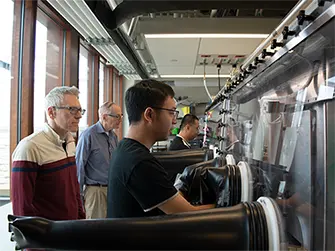Research Spotlights
Tobin Marks Group

Researchers from the Tobin Marks Group at Northwestern University engage with the resources of the GIANTFab Lab for numerous projects related to improved solar cell production. There, Tobin Marks, the Vladimir N. Ipatieff Professor of Catalytic Chemistry and Chemical and Biological Engineering, and his team are building on Northwestern’s legacy as a leader in solar energy discovery.
Motivated by the need to produce green, sustainable energy sources, Research Professor Antonio Facchetti and others have developed new ways of producing bulk-heterojunction organic solar cells to expand the cells’ potential for the future. In particular, the team is interested in creating cells that are stretchable and semi-transparent so they can be employed on more surfaces, such as home and office windows. The nitrogen environment available in the GIANTFab lab allows the researchers to advance their solar cell fabrication rapidly and efficiently.
The team works with organic (i.e., plastic) solar cells, which are made of materials that are abundantly available, non-toxic, and flexible. The cells are appealing to produce because they put a lower stress on natural resources than previous models of solar cells. Additionally, their low cost makes them an attractive option. However, they present challenges that must be addressed before they can be produced for mainstream application.
Current organic solar cell models have either low performance or are made with incredibly complex materials in order to attain performance. Additionally, they often require air or water exclusion to be constructed to prevent environmental degradation. The Tobin Marks Group research addresses these points by developing new materials for the two types of semiconductors found in solar cells: donor and acceptor semiconductors.
In 2020, a new donor semiconductor material Facchetti and his collaborators in the Tobin Marks Group made set a record-high for performance efficiency in converting sunlight to electricity. The group also pioneered innovations in electron-extended acceptors and fluorinated acceptor strategies that improve performance alone and even more so when combined with other acceptors. In addition, their research yielded new tunable acceptors with similar performance to the additive acceptors but with the caveat of the material being changeable if needed.
The team has also been working on new flexible solar cells, alongside others in the GIANTFab lab, that have capabilities in wearable technology.
 Another team from the Tobin Marks Group is working to fabricate and measure solar cells using innovative, new materials. They aim to develop less costly, more efficient, and more stable solar cells for the future.
Another team from the Tobin Marks Group is working to fabricate and measure solar cells using innovative, new materials. They aim to develop less costly, more efficient, and more stable solar cells for the future.
They are working with an emerging class of organic perovskite cells that are lightweight, low cost, and flexible thin films. These third-generation solar cells are challenged by efficiency and stability, which the new research aims to improve.
Solar cells are made of multiple layer components that enable them to work. The team looks specifically at the interlayers of the cell devices and how changing the material can improve stability and performance. In a collaboration with the research teams of Michael R. Wasielewski, Claire Hamilton Hall Professor of Chemistry; Director of the Center for Molecular Quantum Transduction (CMQT); Executive Director of the Paula M. Trienens Institute for Sustainability and Energy, and Mercouri Kanatzidis, Charles E. and Emma H. Morrison Professor of Chemistry, their work in this area has led to improved performance and the incorporation of a material that has increased stability in the solar cells.